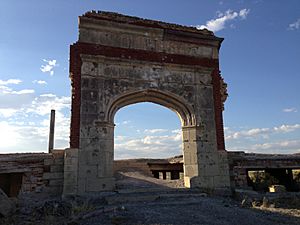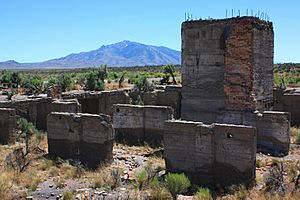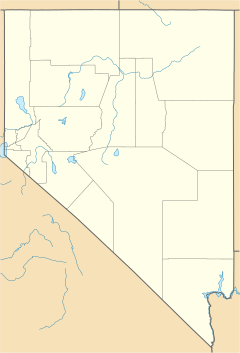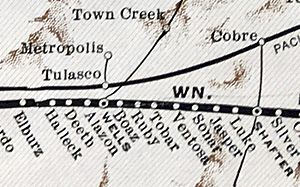Metropolis, Nevada facts for kids
Quick facts for kids
Metropolis, Nevada
|
|
|---|---|

Ruins of Lincoln School, Metropolis, Nevada (2014)
|
|
| Country | United States |
| State | Nevada |
| County | Elko |
| Time zone | UTC-8 (Pacific (PST)) |
| • Summer (DST) | UTC-7 (PDT) |
Metropolis, Nevada is a fascinating ghost town located in Elko County, Nevada. It's about 12 miles (19 km) northwest of a town called Wells. A ghost town is a place where most people have left, and it's often left with empty buildings or ruins.
Contents
The Dream of Metropolis
In the early 1900s, many people tried to start farms in the Great Basin area. This included parts of western Utah and northeastern Nevada. The idea for Metropolis came from a businessman named Harry L. Pierce. He was from Leominster, Massachusetts. Other investors from Massachusetts and Salt Lake City also joined him.
Building a New Town
In 1910, Pierce's company, Pacific Reclamation Company, bought 40,000 acres (16,000 ha) of desert land. They hoped to turn this land into a huge farming area. They hired a well-known contractor, P. J. “Pat” Moran, to build a dam. This dam was on Bishop Creek, about 15 miles (24 km) east of where the town would be. The dam was meant to create a reservoir for watering the farms.
Once the dam was finished, the company worked hard to get people to move there. The LDS Church (Mormon Church) even encouraged its members to settle in Metropolis. Because of this, most people in the town were Mormon. No church building was ever built in Metropolis. Instead, the Mormons used the town's amusement hall as their meetinghouse.
To show that the town was here to stay, the company built many impressive structures. They built:
- an amusement hall
- a post office
- a school
- a train depot
- a grand, modern hotel
The hotel was very advanced for its time. It had its own electric generator, central heating, and hot and cold running water in every room! A special railroad track was added to the town, and regular passenger trains started running in 1912. The town quickly grew to almost 700 people.
Facing Challenges
Even though Metropolis seemed successful at first, it soon ran into big problems.
Water Troubles
Harry Pierce had not gotten the legal rights to use the water from Bishop Creek. The town of Lovelock, which was downstream, sued to stop Metropolis from holding back the water with its dam. Because the residents couldn't use the dam's water for irrigation, many tried "dry-farming" wheat. This means growing crops without irrigation, relying only on rainfall. It worked well for a few years.

Pests and Nature
After settlers killed many coyotes (which eat rabbits), the number of jackrabbits grew a lot. These rabbits ate the wheat crops, causing big problems for farmers. The farmers fought back using guns, poison, and organized hunts. They killed thousands of jackrabbits and even sold them in San Francisco.
Dry-farming only worked for a short time because there was unusually high rainfall during those years. When the rainfall went back to normal, and Mormon crickets appeared, the dry-farming experiment ended.
The End of a Dream
The Pacific Reclamation Company went bankrupt in 1920. In 1922, the railroad stopped its service to Metropolis. By 1924, only about 200 people were left in the town. The amusement hall and the grand hotel both burned down. The last store closed in 1925, and the post office closed in 1942.
The few people who stayed turned to ranching. By 1950, Metropolis had truly become a ghost town. Today, ranches surround the old town site. All that remains are the ruins of the hotel, the school, and a cemetery.
See also
 In Spanish: Metropolis (Nevada) para niños
In Spanish: Metropolis (Nevada) para niños




